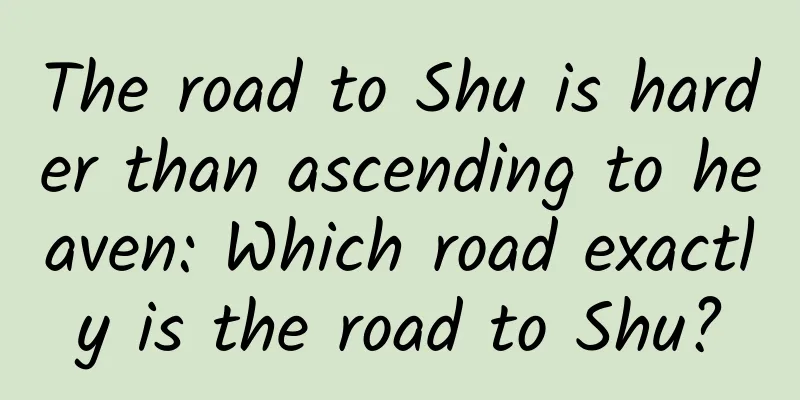The road to Shu is harder than ascending to heaven: Which road exactly is the road to Shu?

|
The road to Shu is as difficult as ascending to heaven: Which road exactly is the road to Shu? Author: Pan Jianbin, Ma Quanbao, Dong Yanlei This poem is a gift to a friend written by Li Bai using the old title of Yuefu. The whole poem has a unique imagination, a free and unrestrained style, and is bold and unrestrained. The poet generally wrote it according to the clues from ancient times to the present, from Qin to Shu. From "Alas" to "Hooked together", the origin of Shu Road is described, and the mythological story of the ancient Shu Kingdom and the Five Dings opening the mountain is dotted with bizarre colors, setting a bold tone for the whole poem. From "There are six dragons on the high peaks that turn the sun back" to "It makes people wither their red faces when they hear this", the high and dangerous mountains are described in great detail. Not only are "high mountains connecting the sky" and "rushing waves back to the river" directly described, but also "yellow cranes" and "monkeys" are used as contrasts, and the traveler is imagined to be in the tension and difficulty of the journey, and can only "sit and sigh with his hands on his chest". So far, the difficulty of Shu Road seems to have come to an end, but the poet's pen turns and uses "asking you" to introduce "travel melancholy", bringing readers into a desolate world of ancient trees. Finally, he wrote about Jiange, a fortress in Shu, and paraphrased the line from Zhang Zai's "Jiange Inscription" in the Western Jin Dynasty: "A place with a favorable geographical location should not be inhabited by people who are not relatives," expressing his worry and concern for state affairs. Where is the Shu Road? The character "Shu" first appeared in the oracle bone script of the Shang Dynasty, which looked like a bug with big eyes. Later, the Sichuan Basin was named "Shu". In a broad sense, "Shu Road" can refer to the road leading to Sichuan, but in a narrow sense, "Shu Road" specifically refers to the road connecting the Guanzhong Plain in Shaanxi with the Hanzhong Basin and the Sichuan Basin. At present, the broad Shu Roads that can be verified are: Qin Shu, Long Shu, Dian Shu, E Shu and the Ancient Tea Horse Road. The Shu Road involves 11 cities including Xi'an in Shaanxi, Guangyuan and Mianyang in Sichuan, with a total length of more than 1,000 kilometers. The Shu Road in Hanzhong area runs through the north and south, recording the historical changes over the past three thousand years. The past and present of Shudao The Shu Road is a road between the ancient Qin and Shu states. It is the road from Guanzhong to Hanzhong and Bashu. It has existed for at least 3,000 years since King Huiwen of Qin conquered Shu. During the Spring and Autumn Period and the Warring States Period, the Shu Road was called "Plank Road", and the name "Shu Road" was first seen in historical documents during the Three Kingdoms period. During the Three Kingdoms period, Zhuge Liang attached great importance to the construction and maintenance of Shu Road. The Bashu region had been fought over by Cao Cao and Liu Bei, and the famous battle of Hanzhong took place there. This battle contributed to the situation of the Three Kingdoms and also witnessed the important military status of Shu Road. Shu Road was also the road from Chang'an and Luoyang to Sichuan during the Han and Tang Dynasties, and was the artery of national transportation. The Shu Road was an important node connecting the Central Plains and the Southwest in ancient China. It was most frequently used during the Warring States Period, the Three Kingdoms Period, the Southern and Northern Dynasties, the Tang Dynasty to the Northern Song Dynasty, and the confrontation between the Southern Song Dynasty and Mongolia, and existed mainly as a military passage. There are seven ancient plank roads in the Qinba Mountain area, including four in the Qinling Mountains: Gudao, Baoxiadao, Tangluodao, Ziwudao, and three in the Bashan Mountains: Lizhidao, Micangdao, and Jinniudao. The Jinniudao is the one described in Li Bai's "The Difficult Road to Shu", and the most famous one is the Lizhidao where Emperor Xuanzong of Tang sent fast horses to deliver lychees for Yang Guifei. The Shu Road is a geographical concept. When people were in its unique geographical space and were constantly stimulated, the literary image of "Shu Road" gradually formed, and appeared in the form of "Shu Road is difficult". There are countless poems about "Shu Road" in ancient my country. In 2011, the application for the Shu Road to be listed as a world heritage site was launched in Guangyuan, Sichuan; in January 2016, Sichuan Province included seven cultural resources including Wuhou Temple, Du Fu Thatched Cottage, Jinsha Site, Qiongyao Site, Wang Jian Tomb, Zhu Yue'an Tomb and Ming Shu King Tombs into the Shu Road, and applied for the dual world natural and cultural heritage. “The world’s most magnificent, bizarre and extraordinary sights are often found in dangerous and remote places.” As the main road connecting Sichuan with the Central Plains, the Shu Road is a witness to the development of China’s roads and has extremely high scientific and historical value. |
<<: Placing a cactus in front of your computer can "absorb" radiation? Don't be too far-fetched!
>>: Can the human body be directly exposed to space?
Recommend
Is it better to fry or cook the gorgon fruit raw?
We all know that Poria cocos can be divided into ...
The 119-year-old special theory of relativity and the 109-year-old general theory of relativity, which one is relative to?
Audit expert: Qian Hang Aerospace science expert ...
The efficacy and function of green wine jar
I believe many people are familiar with the Chine...
What is the recipe of Cistanche deserticola?
Everyone knows that Cistanche is a medicinal mate...
The efficacy and function of large leafy vegetables
We know that there are many kinds of Chinese medi...
Sea otters: Not only cute, but also clean marine forest heroes
Sea otters are a type of marine mammal that lives...
My scalp is tingling! 47! Multiple pathogens were detected, all from abroad
recently, Xiamen Customs An aircraft entering for...
Can we predict adult height by cracking the "code" of bone age?
Author: Li Kai, attending physician, Beijing Jish...
The efficacy and function of Arisaema confusa
The traditional Chinese medicine Arisaema consang...
Why does this part of my body itch so easily?
One minute with the doctor, the postures are cons...
8.15 Japan surrenders! A comprehensive review of the Anti-Japanese War
The above content is excerpted from: "Comic ...
What are the Chinese herbal medicines for clearing and moistening the lungs?
In traditional Chinese medicine, most are made fr...
Seasonal changes on the tip of your tongue: Can you eat out-of-season fruits?
For a long time, people have had a subtle attitud...
Alibaba CMO Wang Shuai talks about Double 11 expectations: Worried that sales exceeding 30 billion will overwhelm logistics
Tmall has been keeping silent about its sales for...









